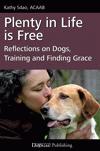
Publisher: Dogwise Publishing, Wenatchee, WA, 2012
Most dog trainers are conscientious people who work very hard to stay abreast of the latest protocols, looking for new and improved methods of working with dogs, especially those with issues. One protocol which burst onto the scene several years ago is known as “Nothing In Live Is Free (NILIF),” “Work to Earn,” and a variety of other names. The methodology suggests s require dogs to perform some behavior on cue in order to receive anything – food, water, access to outdoors, and even attention/affection. Many trainers jumped on the bandwagon and coached their clients to restrict the dogs’ access to everything. Clients obliged and some took it to the extreme, even isolating the family dogs from each other, never allowing them to interact and play. A few trainers and s are still onboard for the ride, but the ultra-restrictive procedural method is – thankfully – no longer popular with most today.
Kathy Sdao’s recent publication is a brief journey through the events in her life which have guided her into re-evaluating the framework of programs like NILIF and the effect they have on our relationships with our dogs. Questioning the effectiveness and morality of requirements such as “ignore your dog if he seeks attention by nudging your hand,” she explores the weaknesses of such programs and the damage they can cause to the bond.
Not one to merely preach and condemn from the mountain top, Ms. Sdao provides an alternate plan with her S.M.A.R.T. x 50. S.M.A.R.T. is the acronym for See, Mark, And Reward Training, an easy-to-implement exercise which can be adjusted to meet the needs of almost anyone. While she recognizes this certainly is not a panacea for all issues which may befall a dog, it can be an integral part of the plan while other interventions are instituted.
The length of a book is not directly proportional to the wisdom contained within. Plenty in Live Is Free is a quick read at only 93 pages plus 3 additional pages of suggestions for further reading. For those with little spare time to read tomes, this book can validate the move away from coercion and into empowerment, not only for the dogs, but for the people as well. As Ms. Sdao writes: “This might free us to loosen our stranglehold on controlling our dogs’ every pleasure, thereby discovering that despite our deep fear that all would be chaos without us In Charge, all will actually be okay. Radically so. What a relief for us and everyone around us.”
